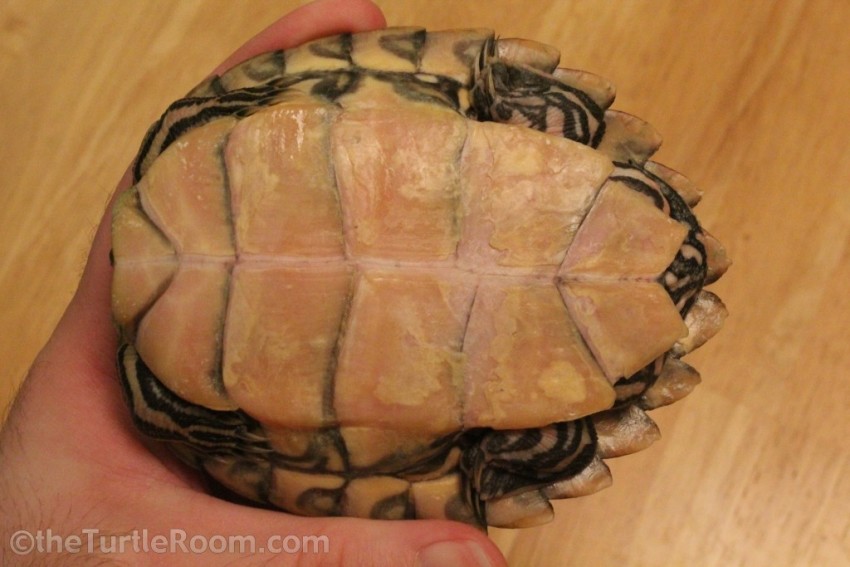Description and Identification
Graptemys barbouri is a medium to large map turtle. Females will typically reach 11-12” (28-30cm) SCL, max 13” (33cm), while males stay considerably smaller at 4-5” (10-12.5cm) SCL, max 5.3” (13.5cm). The carapace is brown with a strong vertebral keel with dark spines that become smaller with age. It has yellow to orange C-shaped markings on the pleural scutes. The marginals also are marked with a bar of the same color. The posterior edge of the carapace is serrated. The plastron is off-white to yellow-white with almost no patterning. If a pattern is present, it is merely lines across the plastron seams. The skin of the head, neck, legs, and tail is dark olive to black with yellow markings. Graptemys barbouri is a member of the broad-head group of map species, and thus the females have heads that get considerably large as they age. The head of the male stays more proportional to the size of the turtle. The eyes are yellow in color with a transverse bar through the pupil. The primary identifying feature of the Barbour’s Map Turtle is the “flower” or “Y” shape on the top of the head. There is also a transverse bar or “chin strap” across the front of their lower jaw. Males will have longer and wider tails with the cloacal opening 1/2 to 2/3rds of the way down the tail and a more juvenile appearance. Females will have shorter, narrower tails, a much larger build, and as mentioned before, much broader heads.
Distribution
Barbour’s Map Turtle is native to the United States; Southwestern Georgia, Northwestern Florida and a small part of Alabama. It is endemic to the Apalachicola, Chipola, Chattahoochee, Flint, and Choctawhatchee River systems and their tributaries. In the Pea and Choctawatchee Rivers, which drain into the Choctawatchee Bay in Florida, it lives sympatrically with G. ernsti.
Native Habitat
The habitat of G. barbouri is typically a clear, limestone-bottomed stream or river with high banks and a multitude of off-shore basking sites. It does occasionally inhabit waters with sandy bottoms and low water clarity. During times of high water, they tend to move into the flood region where current is weakest. This suggests G. barbouri prefers slow currents to fast. Typically, there is an abundance of gastropods available in the habitat.
Wild Diet
Large specimens, especially females, feed mainly on mollusks, including snail and some clams. Crayfish are also a common diet item. Adult males tend to eat mostly insects and insect larvae. Plant matter is not a major part of the diet of wild Graptemys barbouri at any stage of life. Adult females consume almost no plant matter at all.
Behavior
Graptemys barbouri is fond of basking and will bask year-round on rivers in Northern Florida. This species has been observed basking in air temperatures as low as 50F (10C). Typically, basking sites used by adults are located in full sun and extend out over the river. Occasionally, they will bask on exposed limestone ledges. Juveniles often bask on smaller logs and floating plant debris. This species rarely ventures onto land, except to nest. They will move back and forth from the sides of the river to take full advantage of sun for basking.
Reproduction
Males are sexually mature at a minimum PL of approximately 2.7" (6.9cm), which they typically reach by the time they are 3-4 years old in the wild. Females mature at a PL around 6.9" (17cm), which may require as many as 15-20 years to reach. Captive specimens tend to grow more quickly due to a year-round growing season.
Courtship is similar to that of other Graptemys species; it begins with the males positioning themselves in front of the female and making nose contact. The male then "fans" the side of the female\'s head with the inner sides of his legs.
Nesting season runs from late April through early August and, by observations, they prefer to nest in the morning. They are thought to be capable of up to 3-5 clutches per year. Clutch size is from 3-15 eggs, 7-10 is normal. They exhibit TSD-1a, with eggs at 25C (77F) producing all males while 30C (86F) produces all females. The pivotal IT is approximately 29C (84F).
This Care Guide is an external Care Guide. While it is possible this care guide may not be for the exact species you were looking for, it provides information suitable for your species. This Care Guide link will take you away from theTurtleRoom. We only link to care guides we trust. Thanks for visiting theTurtleRoom.org.
Care GuideIf you would like to contribute to the photo gallery of any turtle or tortoise species, please email us at [email protected]. You will be credited for any photos you contribute.
| Graptemys barbouri |
| (Carr and Marchand, 1942) |
| IUCN Red List: |
 |
| Vulnerable A2bcde (2011) |
| Order: | Testudines |
| Suborder: | Cryptodira |
| Superfamily: | Testudinoidea |
| Family: | Emydidae |
| Subfamily: | Deirochelyinae |
| Genus: | Graptemys |
| species: | barbouri |
| CITES: | Appendix III |
| U.S. Legal Status: |
| No possession in Alabama or Georgia, limit of 2 in Florida. No wild collection allowed. |
Author:
Editors: Stephen J. Enders, Anthony Pierlioni, Chris Leone, Andrew S. Weber, Ben Forrest, and Andrew Hermes
Sources
Disclaimer: The Species Profiles - Natural History, Care Guide, and Photo Gallery database is an educational resource. It does not cover all Chelonian species in the world, nor does it include all the latest scientific information about the species covered. Though we edit our accounts for accuracy, we cannot guarantee all information in those accounts. While theTurtleRoom's staff and contributors provide references to books and websites that we believe are reputable, we cannot necessarily endorse the contents of references beyond our control.

This work by theTurtleRoom is licensed under a Creative Commons Attribution-NonCommercial-ShareAlike 4.0 International License.

























































































































































